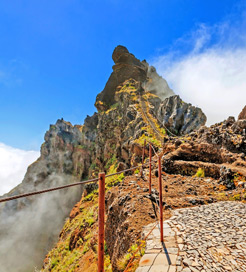
-
Recent Searches
Recent Searches
- Travel Alerts
- My Account
- Customer Service
-
United Kingdom

Compare ferries from Pico to Sao Jorge
There are 2 ferry routes operating between Pico and Sao Jorge offering you combined total of 14 sailings per week. Atlanticoline operates 2 routes, Sao Roque to Velas runs 10 times per week & Madalena to Velas about 4 times weekly.
As the frequency and duration of crossings on some routes varies we would advise that you do a live search for crossings from Pico to Sao Jorge to get the most up to date information.
Pico Sao Jorge Ferry Map
About Pico:
Pico is the second largest island in the Azores, a Portuguese archipelago in the North Atlantic Ocean.
With a landscape dominated by exotic plants and its namesake volcano, Pico is one of the best islands in the Azores for hiking and mountain biking. Wine production also plays an important role in Pico’s culture, with UNESCO protected vineyards in the towns of Lajido, Cabrito and Madelena, which are all well worth seeing.
Pico boasts the finest natural swimming holes in the archipelago, too, and the longest lava tube in Europe, which reaches over 3 miles, so there’s plenty to enjoy whilst exploring the island.
Given Pico’s central location in the Azores, it is a good departure point for the rest of the archipelago. From the island’s main port on the north-central coast, numerous ferry routes are provided to most of the other islands.
About Sao Jorge:
Sao Jorge is a slim stretch of land, measuring fifty-six km long and just eight km wide, in the Azores archipelago, a chain of Portuguese islands in the North Atlantic Ocean.
Undulating peaks, countless emerald-green craters and steep, jagged cliffs encompass some of the ever-changing landscape on this hiker-friendly strip of the Azores. At over a thousand metres, Pico da Esperanca is the highest point, affording lovely views of the surrounding Central Group islands: Faial, Pico and Graciosa. Velas, Sao Jorge’s idyllic capital, sprawls around its picturesque harbour, which dates back to the 1400s, and the town itself has a beautifully made, traditional Azorean bandstand in the main plaza.
The main port of Sao Jorge is in Velas on the northwest coast, which is easily reachable from the majority of Azorean islands by ferry, with some routes from the other Central Group lasting just a couple of hours.


